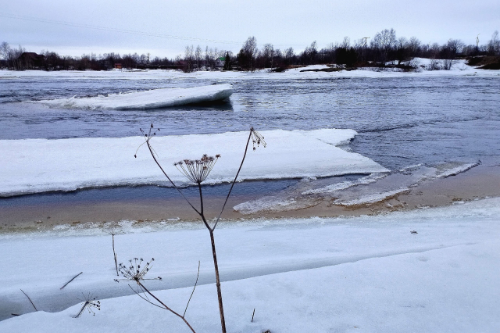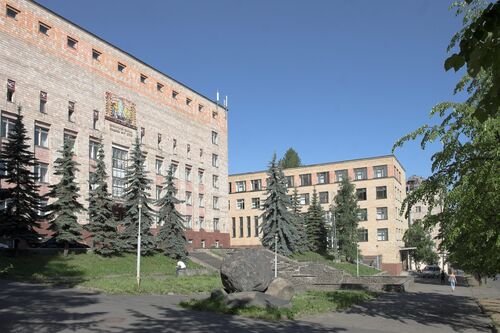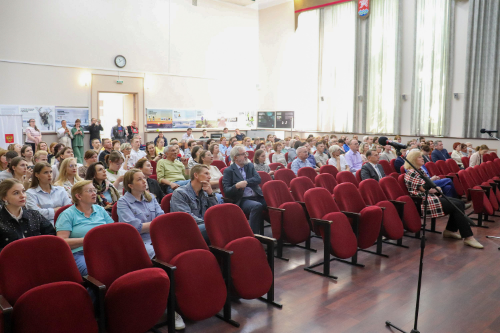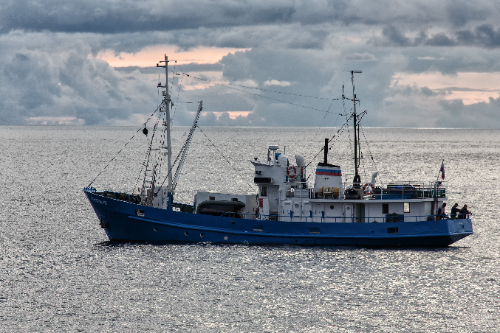– We focused specifically on the estuarine areas because the ice regime in these zones is a highly sensitive indicator of climate change. According to hydraulic laws, river flow velocity decreases significantly in widening areas, so this factor has less effect on ice-on dates, while the key determinant is the temperature decrease, – explained Senior Researcher of the Geography and Hydrology Laboratory, NWPI KarRC RAS, Vyacheslav Baklagin.
For their research, the scientists relied on mean daily temperature data from coastal hydrometeorological stations operated by Roshydromet (the Russian Federal Service for Hydrometeorology and Environmental Monitoring). Information on the onset timing and duration of ice-related phenomena was obtained from observational records collected at nine gauging stations. Additionally, the study incorporated data from the Russian State Water Cadaster and the Automated Information System for State Monitoring of Water Bodies.
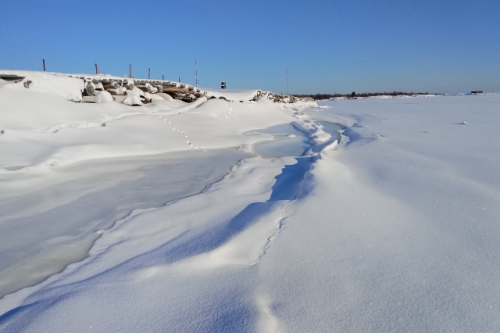
Ice in Kem River mouth
The study sampled the dates when ice phenomena started in the fall, ice-on dates, start and end of spring ice phenomena – ice break-up and the duration of the ice-covered period and the period with ice phenomena in general. As a result, continuous 64-year-long data series were built. Having treated them, scientists obtained averaged characteristics of the rivers’ ice regime. They found that the freezing period on rivers of the White Sea western coast mostly took place between the last third of October and the last third of November. If cooling happened early in some years, such as 1961 and 1974, the first ice formations were observed in the first half of October, as opposed to the last days of November in the warmer winters of 1968, 1997, 2006.
Ice break-up in spring usually occurs in the second half of April (average break-up date is April 22). The rivers become ice-free in early May.
The study revealed that since the late 1980s, temperatures along the western coast of the White Sea have risen significantly, leading to a shorter duration of ice-related phenomena. The turning point occurred between 1988 and 1990. Statistical analysis of long-term fluctuations in mean air temperatures during the cold season showed that lately, between 1991 and 2020, temperatures were 1.4°C higher compared to the 1956–1990 period. Regression analysis over the entire 64-year study period indicated that the cold season’s mean air temperature in the region increased by 2.7°C.
The results of the study were published in the Ice & Snow Journal.
"Analysis of long-term patterns in cold-season’s air temperatures along the White Sea western coast reveals that in recent decades (1991-2020) average temperatures have been rising at a rate of 0.42°C per decade. This finding aligns with global warming trends observed by researchers for Arctic water bodies and rivers over the past decades", - states the scientific paper.
The temperature rise has reduced the period with ice-related phenomena by 21 days. Notably, over the past 30 years, its duration in northern rivers has decreased by nearly two weeks compared to the 1956-1990 period. During these years, the average timing of stable ice phenomena formation has shifted one week later. Ice breakup and ice-off now occur earlier on average, also by about one week. Overall, the period with ice phenomena is shrinking at a rate of 3.3 days per decade.

Time curve for the duration of the period with ice phenomena on rivers on the White Sea western coast (1) and its linear trends in the periods 1956–2020 (2), 1956–1990, and 1991–2020 (3)
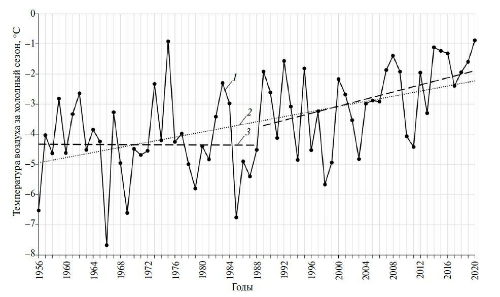
Long-term fluctuations of cold season’s mean air temperature on the White Sea western coast (1) and its linear trends in the periods 1956–2020 (2), 1956–1990, and 1991–2020 (3)
Accurate forecasting of river ice formation and breakup is crucial for various sectors, including shipping, fisheries, and winter road maintenance. Understanding these processes is critical for prevention of and preparedness for emergencies – floods, dam breaches and other hazards caused by ice jamming and the resultant water level rises. The findings from Karelian scientists will help refine and update Roshydromet's reference data, which is essential for developing improved hydrological forecasting methods.
The article "Long-term variability of ice regime characteristics in river estuaries along the White Sea western coast under climate change" made Vyacheslav Baklagin the winner of the 2024 KarRC RAS Young Scientist Contest. The senior researcher specializes in processing satellite data on ice phenomena.
– We now plan to compare in situ data from marine hydrometeorological stations with satellite imagery to check how accurately the latter render the situation on sea and lake water expanses, – shared Vyacheslav Baklagin about the plans.
According to the researcher, satellite observations offer undeniable advantages over other data collection methods, but have a major drawback of being insufficiently reliable
– Publicly available satellite data may have limited spatial resolution, but it's generally sufficient for assessing ice regime trends in large water bodies. However, the algorithms used to interpret the signals received by sensors do not always function correctly and can produce significant errors in ice detection. This is particularly true for the microwave mode, which remains operational under all weather conditions and thus holds substantial practical value. We’d like to quantify these errors and determine whether satellite data are suitable for assessing long-term ice regime variability in water bodies such as the White Sea, – summed up the researcher.
Photos: Aleksey Tolstikov / Northern Water Problems Institute KarRC RAS




